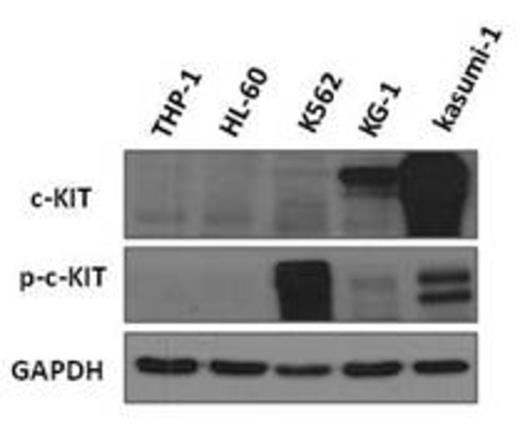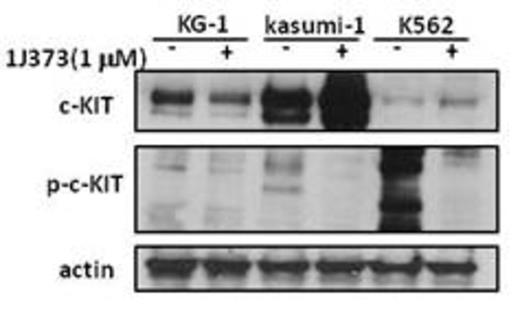Abstract
Acute myeloid leukemia (AML) carrying t(8;21)(q22;q22) and inv(16)/t(16;16)(p13;q22) are classified as French-American-British (FAB) AML subtype M2 or monocytic with eosinophilic differentiation (M4Eo) by morphology and as core binding factor (CBF)-AML according to pathogenesis. CBF-AML accounts for approximately 15% of AML and frequently harbors c-KIT mutation (17∼46%). C-KIT mutated CBF-AML patients usually have higher baseline white blood cell count, higher relapse rate and shorter event free survival/overall survival after conventional chemotherapy than those without c-KIT mutation. It is conceived that c-KIT mutation is a crucial hit and cooperates with AML1-ETO resulting from t(8;21)(q22;q22) to cause overt AML. Imatinib, a tyrosine kinase inhibitor suppressing c-KIT activation, has been used in c-KIT mutated AML, systemic mastocytosis (SM) and gastrointestinal stromal tumor (GIST). However, c-KIT exon17 D816V mutation, a frequent mutation of CBF-AML and SM, is associated with primary imatinib resistance.
1J373, a multi-targeted tyrosine kinase inhibitor, which was initially designed as a FLT3 inhibitor but later found to target c-KIT as well. It has been shown to effectively inhibit the proliferation of FLT3-ITD mutated leukemia cell lines, MV4;11 and MOLM-13, both in vitro and in vivo. (unpublished data) Among a series of myeloid leukemia cell lines without FLT3-ITD mutation, including THP-1, HL-60, K562, KG-1, and kasumi-1, the sensitivity to 1J373 is closely associated with the presence of constitutive c-KIT activation (Figure 1A). The IC50 of 1J373 for cells with (K562, KG-1 and kasumi-1) and without (THP-1 and HL-60) constitutive c-KIT activation was below 50 nM and beyond 1000 nM, respectively. 1J373 suppressed the phosphorylation of c-KIT for cell lines with constitutively activated c-KIT, which suggested that 1J373 may suppress the proliferation of KG-1, K562, and kasumi-1 by inhibiting c-KIT (Figure 1B).We further compared the efficacy of 1J373 and imatinib in kasumi-1, a cell line with t(8;21)/AML1-ETO and c-KIT exon 17 N822K mutation. At 1000nM of concentration, the phosphorylation of c-KIT was effectively inhibited by imatinib at 2-hour but partially recovered after 8 hours; while 1J373 treatment resulted in a sustained inhibition for 24 hours. The inhibition of c-KIT activation by both agents was accompanied with corresponding changes in the phosphorylation status of its downstream signaling pathway molecules, including PI3K, AKT, mTOR, and MAPK (Figure 2). 1J373 induced cell cycle arrest of kasumi-1 at G1 phase with increase of subG1 population time-dependently and induced apoptosis of kasumi-1 through activation of caspase 8 and 9, and upregulation of proapoptotic proteins Bax and Bak. The in vivo experiments are in progress.
c-KIT and phosphorylated c-KIT expression in myeloid leukemia cell lines
c-KIT and its downstream signalings expression in kasumi-1 cells treated with imatinib and 1J373
c-KIT and its downstream signalings expression in kasumi-1 cells treated with imatinib and 1J373
No relevant conflicts of interest to declare.
Author notes
Asterisk with author names denotes non-ASH members.




